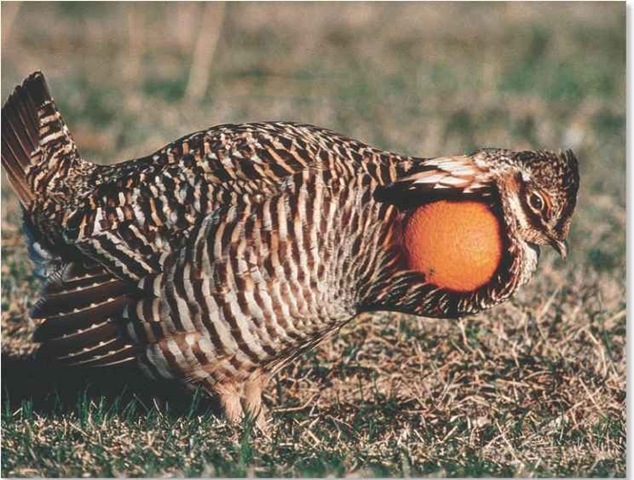ORDER
Galliformes
FAMILY
Tetraonidae
GENUS & SPECIES
key features
Famous for their booming courtship displays, the males’ drumming sounds are heard more than 2 miles away
Prominent, stiff winglike feathers (pinnae) on the neck give rise to their other common name, the pinnated grouse
where in the world!
Inhabits the midwestern United States, including Kansas, Nebraska, South Dakota and Oklahoma, along with small populations in six other states
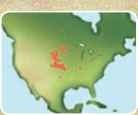
Lifecycle
The greater prairie chicken is an extremely social bird, forming winter flocks of up to 300, which help them stay warm in their cold weather habitats.
Habitat
As its name suggests, the greater prairie chicken is at home on the prairies or rolling grasslands that are found mostly in midwestern U.S. But with the conversion of the virgin prairies into grain farms, the the greater prairie chicken’s current habitat is characterized by medium and tall prairie grasses that are often mixed with cropland. In the spring and summer, the grassland is necessary for the greater prairie chicken to roost, socialize and nest, In winter cultivated grains provide a stable source of food.
Strutting their stuff The males gather on the open prairie to dance.
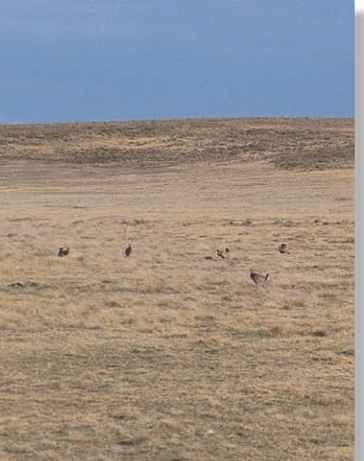
Behavior
Most prairie chickens roost on the ground in sheltered sites, where they hide from predators. During the winter, they make snow roosts by digging 5-10″ beneath the surface of the snow, then tunneling horizontally for about I’.These roosts work like an igloo, protecting the prairie chickens from cold winds. Preening is a common behavior among greater prairie chickens and occurs mainly while roosting, socializing and feeding. The greater prairie chicken spends the majority of its time on the ground, but frequently flies between its breeding, feeding, nesting, socializing and roosting kites. The bird can fly nonstop for more than 7 miles between favored habitats.
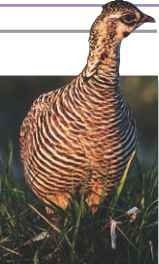
A On alert
When predators approach, adults remain motionless with necks extended.
In dispute Two males dispute territory on a booming ground in the prairie.
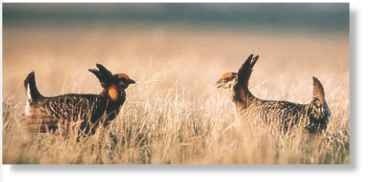
Prairie chickens can fly up to 50 mph when traveling to and from roosting sites.
Prairie chickens have a high mortality rate. As many as 50-60% of adults die each year.
Pheasants lay their eggs in the nests of prairie chickens. The pheasant eggs hatch first, and the mother prairie chicken raises them as her own, neglecting her own eggs — which then never hatch.
Food & feeding
The greater prairie chicken forages on the ground, only occasionally lighting on a tree branch to feed. Groups search for food mainly in the early morning and early evening, and typically rest in thick cover during the day. The winter diet of the greater prairie chicken is almost completely vegetation: leaves, seeds and cultivated grains such as corn, sorghum and wheat. In the spring, leaves, seeds, buds, fruits and insects dominate the diet, the latter being an important source of protein for juveniles. Although the greater prairie chicken may drink from stock tanks when available, it relies mainly on dew from plants to obtain the water it needs.
Open house The open prairie provides shelter as well as food.

Conservation
The greater prairie chicken is in danger of extinction in 15 states. However, they are numerous enough to be legally hunted in four states: Kansas, South Dakota, Nebraska and Oklahoma. Declining numbers are caused by the conversion of prairie land to farmland, where it has suffered the most from human activities. Other threats come from natural predators, such as skunks, foxes and coyotes.
Breeding
Greater prairie chickens mate at lekking sites, with the females generally mating once. However; each season some females breed a second time, because their nest is taken by a predator The female builds her nests alone, forming a bowl-shaped depression in the ground and lining it with feathers, dry grass and leaves. She lays a clutch of 11-12 eggs and incubates them for 23-25 days. Immediately after hatching, the chicks are able to feed themselves. Their diet initially consists of insects, but they gradually develop a taste for seeds, leaves and grains. After 8-10 weeks, the chicks become fully independent.
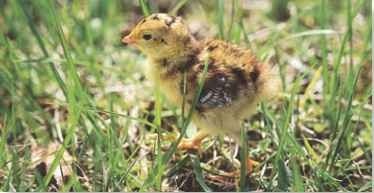
breeding rivalry
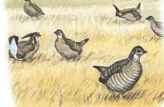
Gathering…
In the spring, the males gather together at the lekking site, which is typically located on open, grassy terrain.
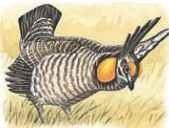
Defending…
Each male establishes and defends a territory through various displays and deep resonating sounds called booms.
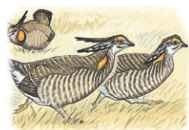
Face off…
Males occupying the central territories are dominant and carry out most of the mating over the entire booming ground.
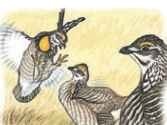
Battle of the dances
When females visit the lek, the males perform fluttering jumps and leaps into the air and flap their wings while booming.
Profile
Greater Prairie Chicken
A bird known for its courtship rituals, the male performs one of the most intriguing mating displays to attract a female hen.

Creature comparisons
The greater prairie chicken is easily confused with the sharp-tailed grouse (Jympanuchus phasianellus). Similar in size and shape, the sharp-tailed grouse also has an inconspicuous comb over its eyes. Pinkish to pale-violet airsacs on the neck expand during display, though not to the degree found in the greater prairie chicken.The sharp-tailed grouse can be recognized by its long, narrowly pointed tail compared to the short, rounded tail of the greater prairie chicken.The sharp-tailed grouse can also be found in parts of Canada all the way down to Utah.
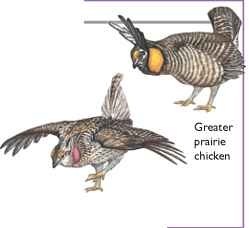
Sharp-tailed grouse
| VITAL STATISTICS | |
| Weight | Male 2-3 lbs.; female 1-2 lbs. |
| Length | 16-19” |
| Wingspan | 22” |
| Sexual Maturity | 1 year |
| Breeding Season | March-May |
| Number of Eggs | 11-12 |
| Incubation 23-25 days ‘ Period | |
| Fledging Period | 8-10 weeks |
| Breeding Intervals | 1 year |
| Typical Diet | Insects, buds, prairie grass, seeds, leaves and grains |
| Lifespan | 2-3 years |
RELATED SPECIES
• The prairie chicken belongs to the order Galliformes, which includes quail, grouse, pheasants . and turkeys. Four subspecies have been recognized: the eastern heath hen (Tympanuchus cupido cupido), extinct since 1932; the endangered Attwater’s prairie chicken (T. c. attwateri) on the Texas Gulf coast; the lesser prairie chicken (T. c. pallidicinctus) in the west; and the greater prairie chicken (T.c. pinnatus).
